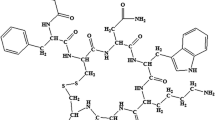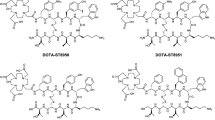Abstract.
In vivo somatostatin receptor scintigraphy using Octreoscan is a valuable method for the visualisation of human endocrine tumours and their metastases. Recently, several new, alternative somatostatin radioligands have been synthesised for diagnostic and radiotherapeutic use in vivo. Since human tumours are known to express various somatostatin receptor subtypes, it is mandatory to assess the receptor subtype affinity profile of such somatostatin radiotracers. Using cell lines transfected with somatostatin receptor subtypes sst1, sst2, sst3, sst4 and sst5, we have evaluated the in vitro binding characteristics of labelled (indium, yttrium, gallium) and unlabelled DOTA-[Tyr3]-octreotide, DOTA-octreotide, DOTA-lanreotide, DOTA-vapreotide, DTPA-[Tyr3]-octreotate and DOTA-[Tyr3]-octreotate. Small structural modifications, chelator substitution or metal replacement were shown to considerably affect the binding affinity. A marked improvement of sst2 affinity was found for Ga-DOTA-[Tyr3]-octreotide (IC50 2.5 nM) compared with the Y-labelled compound and Octreoscan. An excellent binding affinity for sst2 in the same range was also found for In-DTPA-[Tyr3]-octreotate (IC50 1.3 nM) and for Y-DOTA-[Tyr3]-octreotate (IC50 1.6 nM). Remarkably, Ga-DOTA-[Tyr3]-octreotate bound at sst2 with a considerably higher affinity (IC50 0.2 nM). An up to 30-fold improvement in sst3 affinity was observed for unlabelled or Y-labelled DOTA-octreotide compared with their Tyr3-containing analogue, suggesting that replacement of Tyr3 by Phe is crucial for high sst3 affinity. Substitution in the octreotide molecule of the DTPA by DOTA improved the sst3 binding affinity 14-fold. Whereas Y-DOTA-lanreotide had only low affinity for sst3 and sst4, it had the highest affinity for sst5 among the tested compounds (IC50 16 nM). Increased binding affinity for sst3 and sst5 was observed for DOTA-[Tyr3]-octreotide, DOTA-lanreotide and DOTA-vapreotide when they were labelled with yttrium. These marked changes in subtype affinity profiles are due not only to the different chemical structures but also to the different charges and hydrophilicity of these compounds. Interestingly, even the coordination geometry of the radiometal complex remote from the pharmacophoric amino acids has a significant influence on affinity profiles as shown with Y-DOTA versus Ga-DOTA in either [Tyr3]-octreotide or [Tyr3]-octreotate. Such changes in sst affinity profiles must be identified in newly designed radiotracers used for somatostatin receptor scintigraphy in order to correctly interpret in vivo scintigraphic data. These observations may represent basic principles relevant to the development of other peptide radioligands.
Similar content being viewed by others
Author information
Authors and Affiliations
Additional information
Received 8 August and in revised form 26 October 1999
Rights and permissions
About this article
Cite this article
Reubi, J., Schär, JC., Waser, B. et al. Affinity profiles for human somatostatin receptor subtypes SST1–SST5 of somatostatin radiotracers selected for scintigraphic and radiotherapeutic use. Eur J Nucl Med 27, 273–282 (2000). https://doi.org/10.1007/s002590050034
Issue Date:
DOI: https://doi.org/10.1007/s002590050034




